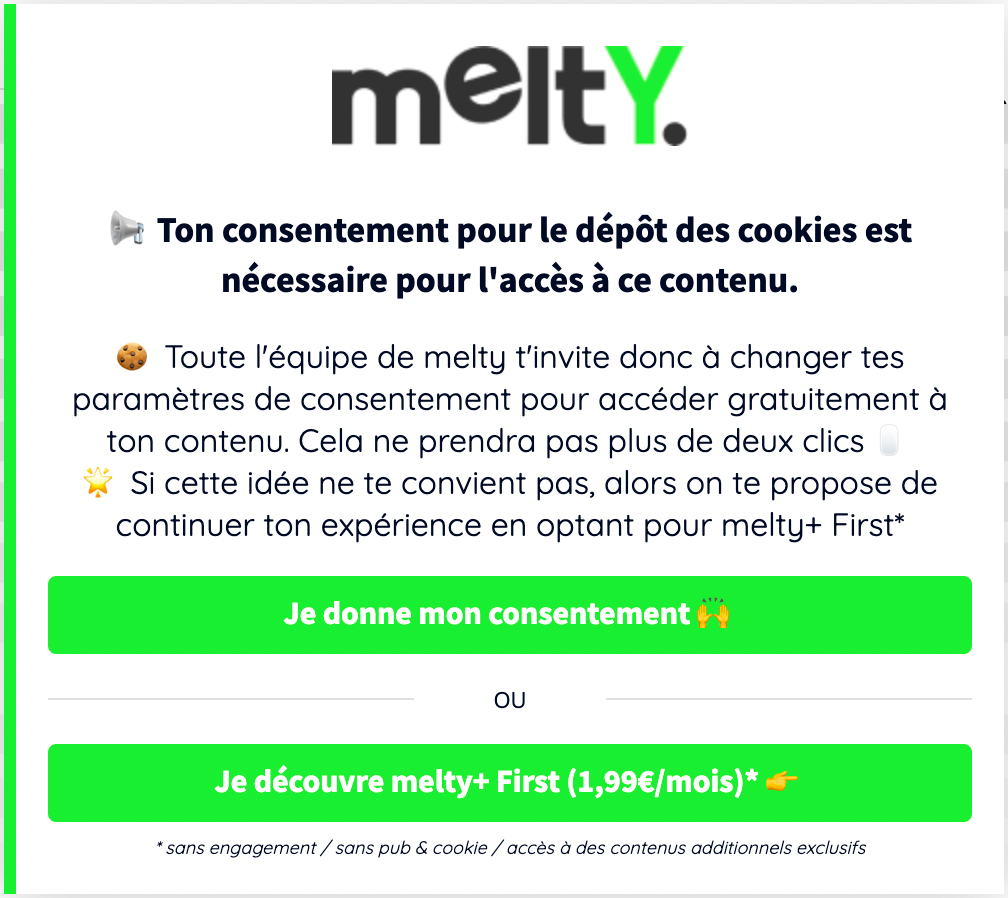A wall is used by content producers on their website to block content and ask a user for a value exchange in order to gain access.
A Cookie Wall with Alternative is no exception. When employed by a publisher, it will be presented to a user if they decline cookies and tracking on the cookie consent notice (this is shown when first entering a site). Given the value of cookies to content producers, the cookie wall alternative offers users a cookie-free option that will benefit the publisher in another way, such as by asking for a user to subscribe or pay a small fee.
Note that there is a difference between a cookie wall and a cookie wall alternative. A cookie wall completely blocks a user from entering their site unless cookies are accepted, without offering alternatives. This isn’t legal in France (according to the CNIL) as users must always be given a cookie-free option to view content. A cookie wall alternative however does give another choice. A user who decides to decline cookies can access the website another way. For example, you could ask that they subscribe as an alternative to accepting cookies. We know it’s a bit confusing but the laws are constantly changing, so make sure to keep up-to-date with the regulations!
Remember, before presenting a Cookie Wall with Alternative, and to comply with EU law, you need to ask your audience for consent to use cookies and tracking. Didomi, a fellow French tech company with clients around the world, have created a Consent Management Platform solution which allows you to gather and store consent in a way that is fully compliant with regulations (such as GDPR).
Want to find out more about cookie wall alternatives, their benefit to publishers and learn about some best practices? Take a look at our dedicated ‘What is a Cookie Wall’ article.
Interested in integrating a cookie wall into your website? Book a free demo now!
The Washington Post
The American daily news publisher, The Washington Post, combines a cookie consent notice and hard Cookie Wall with Alternative into a single page. The user’s options are:
- Consent to cookies and tracking and be able to use the site for free
- Accept cookies but pay for subscription and get all the benefits included in being a subscriber
- Pay a higher subscription fee but get a cookie and ad-free experience
Although this wall is very clearly laid out, the publisher is perhaps prioritizing the promotion of their subscription offers over being transparent about cookie and tracking usage. None of the options explain exactly what cookies are used for nor who the 'third parties' are (who also get to handle the user's personal data). There are though 3 tiny links at the bottom of the page where you can access more information, but a user would have to scroll down to even spot these.
L’OBS
L’OBS is a French news magazine who employ a more ‘freemium’ style Cookie Wall with Alternative. The cookie consent notice appears as we enter the site with a huge amount of information (you can scroll down within the wall). This includes a section describing what happens if you ‘continue without consenting’. The options for the reader therefore are:
- Accept cookies and use the site like normal
- Continue without accepting and read the site for free without cookies, but a promotional banner can pop-up at any time (or throughout your time on the site)
This strategy is great for allowing someone to use the site for free without cookies or tracking, and the publisher can simply promote their subscription offer to try to benefit from the user in another form. Note that, alongside the promotional banner, they describe how they respect the user’s choice but also that L’OBS is the fruit of 135 journalists’ work, something that a reader shouldn’t expect to get for free.
Puremédias (by Ozap)
Puremédias, Jeux Vidéo and Allociné all employ the same hard Cookie Wall with Alternative strategy. As with The Washington Post, the consent notice and wall are integrated into a single page, making the user journey simpler. Two options are available:
- Accept cookies and access the site for free
- Pay a monthly fee of €1 and get cookie-free access
The wall is very informative and explains to a reader that Puremédia relies on ad-revenue to survive, meaning that a user who declines cookies (and so cuts off this revenue stream for the publisher) should pay for content in another form. It’s important to highlight here that cookies and how they benefit content producers online, is fairly unknown by the average internet user. So, asking them to pay as an alternative to cookies and tracking needs to be explained in order to keep them from leaving your site.
In our ‘What is a Cookie Wall’ article, we mention that it’s vital that the alternative to cookies is something that a user could genuinely consider. €1 for a month, the cost on Puremédia, is a very reasonable compensation choice and wouldn’t likely turn users away.
Marmiton
Marmiton, offering recipes and cooking content, has a cookie consent banner followed by a Cookie Wall with Alternative if a user rejects all cookies. Firstly, note that they clearly explain what cookies and tracking is used for on their site, helping users to make a more informed decision. After clicking ‘I don’t accept’, their wall gives two options:
- Accept cookies and tracking (framed here as changing their mind) and access the site for free
- Subscribe to their site without cookies
The cookie wall alternative politely explains to a user that, in the absence of consent to cookie usage, a user is required to pay for access to content.
NPR
NPR (National Public Radio) employs a very different freemium Cookie Wall with Alternative approach which is an interesting one to study. The consent banner asks a user to either accept cookies or see other options. By clicking on the latter, we’re taken to a list of alternatives to accepting cookies. At this point, if we still just want to stay on the NPR site and view their content without cookies, we have to scroll to the top of the page and select ‘NPR’. This takes us to a text-only version of the website (shown in the third image below). If, though, we click on ‘Full Site’, we’re redirected back to the cookie consent banner that we started on.
A positive part of this wall is that a user can still access content for free without cookies and tracking, however the user experience of this text-only version isn’t great and may push a reader to leave the site. What’s more, despite the informative wall, it never really explains that the text-only version is provided as a cookie-free alternative, we’re expected to scroll to the top of the page and discover this ourselves, and clicking on ‘NPR’ takes us back full-circle to the consent notice.
Didomi X Poool
Poool have partnered up with Didomi to bring you an optimized Cookie Wall Alternative for your website. A user will first be confronted with the Didomi consent notice, asking if they accept or decline cookies and tracking. Thanks to Didomi’s expertise in this area, the notice is fully compliant with all regulations, including GDPR and CPRA, and allows you to gather and store consent in a way that respects your reader’s data. If the user chooses to decline, they will be presented with a cookie wall alternative (this is Poool’s part).
As normal with Poool’s solutions, you'll be able to configure every aspect of the wall, such as colors, wording and, most importantly, the compensation choices. This refers to the cookie-free alternative that you offer your user, which can be anything from requiring that they subscribe to simply asking that they register as a user.
For instance, melty offer users who decline cookies the option between changing their mind and accepting cookies or subscribing to their premium offer.

Interested in integrating a Cookie Wall with Alternative into your website? Book a free demo and get an ROI evaluation included!

